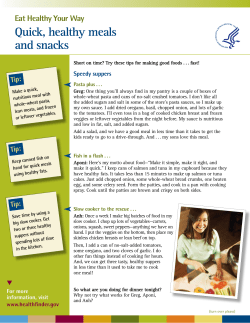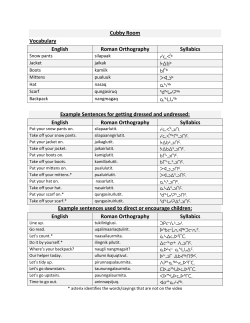
Document 34613
Wellness Newsletter August 2009 Healthy Eating on a Budget You don’t need to shop at expensive health food stores to eat well. Follow these simple steps to save money and splurge on nutrition: Go generic. Generic or store brands offer great savings and typically are just as nutritious. Buy in bulk. Lean meats and poultry can be divided into individual servings and frozen. Rice, beans, oatmeal, nuts and other grains cost much less than prepackaged products. Buy large bags of fruit instead of individual pieces by the pound. Cook and store in bulk. Make dishes on the weekends that you can eat during the week, or freeze and use them later. Pick your protein wisely. Look for lean meat, poultry and fish on sale, and freeze for later use. Beans, tofu and eggs are excellent protein choices and can be good alternatives to pricier animal protein (meat). Be season-savvy. Seasonal fruits and vegetables taste best and are often much less pricey than imported out-of-season varieties. Consider reduced-price produce. It’s usually only a day or two old and can be a good bargain if used quickly. Visit local farmers and ethnic markets for cheap and fresh produce. Convenience counts. If you find your fresh produce often going bad, try frozen varieties. Look for products packed in their own juice, or made without salt or sugar. Stock up on low cost staples, such as brown rice, barley, dried or canned beans and whole-wheat pasta. Plan ahead. Menu planning will help you reduce any waste of produce and other fresh foods. Shoppers without a list tend to buy more food, especially of the snacking variety! Don’t go to the store hungry. You will be more tempted to indulge in items that are unhealthy and more costly. Limit junk food. Use the money you save to buy healthier snack items like fresh avocados, luscious grape tomatoes and crunchy apples. All these are delicious and totally natural. Jane Harrison, RD Pack it up! ‘Knot’ Funny A backpack can be a great accessory to take along on a summertime hike, bike ride or vacation. Just be careful of how much you carry, and how you carry it. Wear both straps. Using only one strap causes one side of your body to bear the entire weight of the backpack, which can increase your risk of muscle strain. Wear the backpack over the strongest mid-back muscles. Your bag should rest evenly in the middle of your back. Adjust the shoulder straps to allow you to put on and take off the backpack without difficulty, and to allow your arms to move freely. If your backpack has them, use waist or chest straps to help transfer the weight. Lighten the load. You should fill your backpack to a weight equal to 10-15 percent or less of your body weight. Pack heaviest items closest to your back to help balance the load. Illinois State Board of Education True or False? Bulletin Board Check out: www.eatingwell.com for recipes and information geared toward eating on a budget. The compound that makes raspberries red also may help keep blood vessels healthy. True – Raspberries are red because of anthocyanins, antioxidants that have been associated with improved blood vessel function. They are also loaded with vitamin C, and are high in fiber. EatingWell.com You don’t have to be exercising to get a leg cramp. How many times have you awoken from a deep sleep with a painful charlie horse? Here are some ideas that may help you avoid nighttime leg cramps: • Don’t tuck in bedclothes; give your feet room to move. Sleep on your side or stomach, with your feet hanging off the end of the bed. • Avoid high heels, as well as completely flat shoes. Choose a comfortable shoe with a low heel. • Massage and stretch your calf muscles in the evening, before going to bed. • To relieve a cramp, flex your foot upward, pointing your toes toward your knee. Or, grab your toes and pull them toward your knee. Massage your calf. Walk around. Applying heat may also help. Try these stretches to limber up your calf muscles: • Place your toes on the edge of a step and lower your heels, allowing your body weight to stretch your calves. Hold the railing for balance. • Stand facing a wall, two to three feet away, with your feet perpendicular to the wall and one foot forward. Lean forward, with your forearms against the wall. Straighten your rear leg, and stretch your heel to the floor. Hold for 10-30 seconds, then switch legs and repeat. UC Berkeley Wellness Letter
© Copyright 2025





















